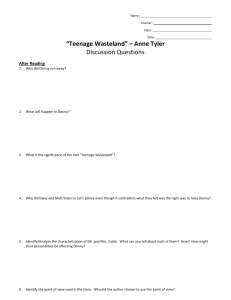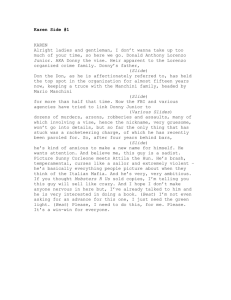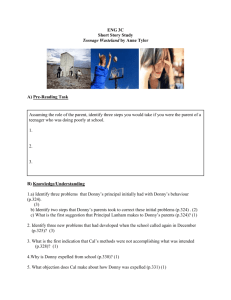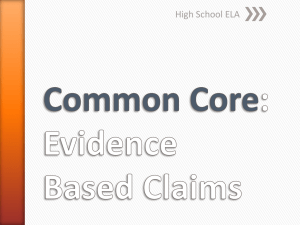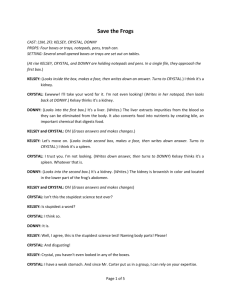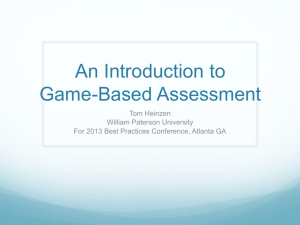Teenage wasteland - YESNet First Class Home Page
advertisement
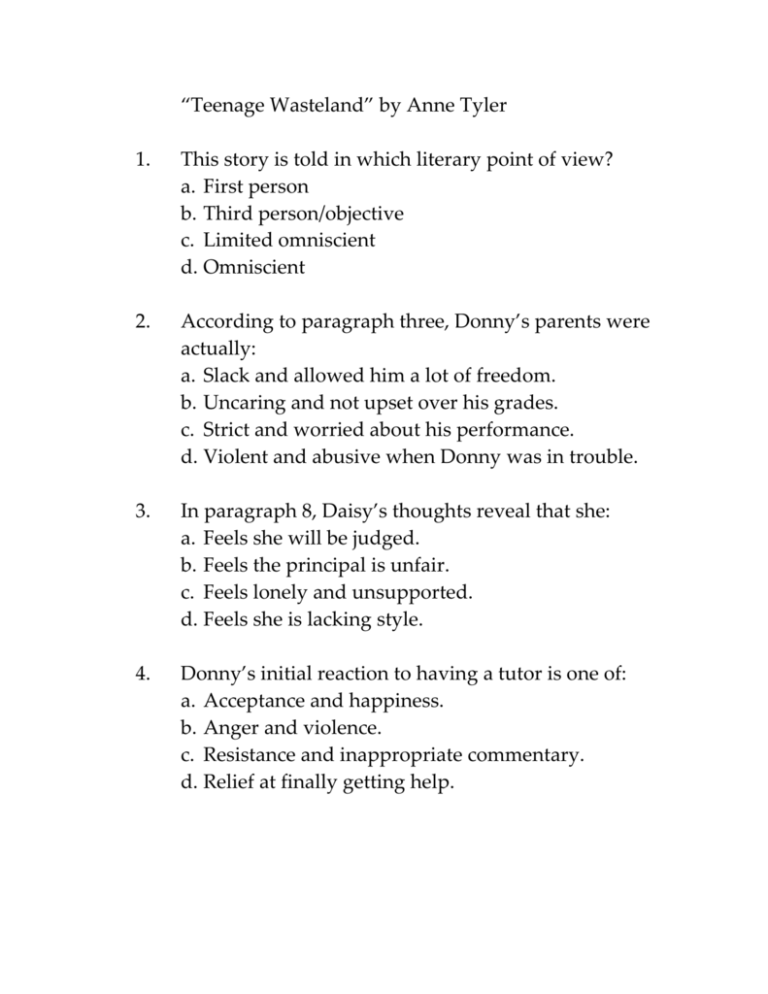
“Teenage Wasteland” by Anne Tyler 1. This story is told in which literary point of view? a. First person b. Third person/objective c. Limited omniscient d. Omniscient 2. According to paragraph three, Donny’s parents were actually: a. Slack and allowed him a lot of freedom. b. Uncaring and not upset over his grades. c. Strict and worried about his performance. d. Violent and abusive when Donny was in trouble. 3. In paragraph 8, Daisy’s thoughts reveal that she: a. Feels she will be judged. b. Feels the principal is unfair. c. Feels lonely and unsupported. d. Feels she is lacking style. 4. Donny’s initial reaction to having a tutor is one of: a. Acceptance and happiness. b. Anger and violence. c. Resistance and inappropriate commentary. d. Relief at finally getting help. 5. The quote which BEST indicates how Cal approaches his students is: a. “Cal shambled to his feet.” ( paragraph 26) b. “Let’s you and me try working together three nights a week.”( 24) c. “His hair was long and stringy as Donny’s”(15) d. “He cuffed Donny’s shoulder playfully.” (29) 6. Cal suggests the root of Donny’s problem is: a. That his parents are too strict. b. That he needs to have a sense of self-esteem. c. That he needs a strong male figure. d. That he needs to play more sports. 7. In paragraph 61, Daisy recognizes the song playing as “Teenage Wasteland” by the Who. The fact that it is playing in Cal’s yard with his students is: a. Symbolic b. Ironic c. Comedic d. Sarcastic 8. Paragraph response - In a paragraph of at least 200 words discuss ONE of the following topics. You must refer to at least 3 examples from the story in your answer. You may include quotations or you may refer to specific events TOPIC ONE: The title of the story is alluded to when Daisy hears “Teenage Wasteland” by The Who. Looking at the lyrics attached to the story, explain how these lyrics connect to the story. TOPIC TWO: The story is told through Daisy’s eyes and the reader often finds she blames herself for Donny’s problems. Who is actually responsible for Donny’s ‘failure’ at school? Why? Planning your paragraph: a. Hook – Catchy subject related statement. General. _____________________________________________________ _____________________________________________________ b. Topic sentence – outlines/answers the question and includes the author and title of the piece. ______________________________________________________ ______________________________________________________ ______________________________________________________ c. Point One ___________________________________ ______________________________________________________ d. Example_____________________________________ ______________________________________________________ e. Explanation _________________________________ ______________________________________________________ f. Point Two ___________________________________ ______________________________________________________ g. Example_____________________________________ ______________________________________________________ h. Explanation _________________________________ ______________________________________________________ i. Point Three__________________________________ ______________________________________________________ j. Example_____________________________________ ______________________________________________________ k. Explanation _________________________________ ______________________________________________________ l. Conclusion – Summarize your answer. Short and sweet. SAMPLE PARAGRAPH – TOPIC – Discuss the use of analogy in “The Metaphor”. Writing about feelings is difficult because they are so abstract, but feelings are key to character development. Budge Wilson’s “The Metaphor” emphasizes the importance extended metaphors, better known as analogies, in developing characters and explaining their relationships. The first analogy occurs when the narrator, Charlotte, is asked to write a simple metaphor about her mother in English class. She begins to write a description of a tall, cold building, pristine and uninviting where “no muddy feet” are allowed. Through her analogy the reader realizes her mother is a cold and uninviting person, who does not appreciate messy or imperfect people or moments. This analogy also suggests the lack of warmth and closeness between the narrator and her mother. Later, the narrator begins to build metaphors while in the bath. In her musing she further develops a picture of her mother by describing her as “barbed wire” and “poison ivy” after her mother makes scathing remarks about the narrator’s favorite English teacher, Miss Hancock. Her analogy using unpleasant and painful metaphors emphasize her cruel and nasty nature. It also provides a moment when Charlotte truly recognizes how her mother judges and interacts with others. When the beloved Miss Hancock is killed (or commits suicide) , the narrator is greatly affected and she writes a tribute to Miss Hancock through Miss Hancock’s favorite tool, the metaphor. Charlotte describes her as “an inexpertly decorated cake” covered in intense icing, yet full of “treasures” and unappreciated by adults. Readers will recognize the praise for Miss Hancock’s flamboyant makeup style and often extremely passionate and expressive nature. They will also recognize that the narrator realizes that Miss Hancock has left her with the gift of metaphor, although her own mother sees no value in it. Through the development of these vital metaphors, Wilson provides us with a deeper understanding of the characters using simple and effective images. POINT! DON’T FORGET TO P. E. E.: EXAMPLE! EXPLAIN!
